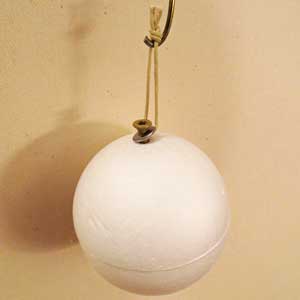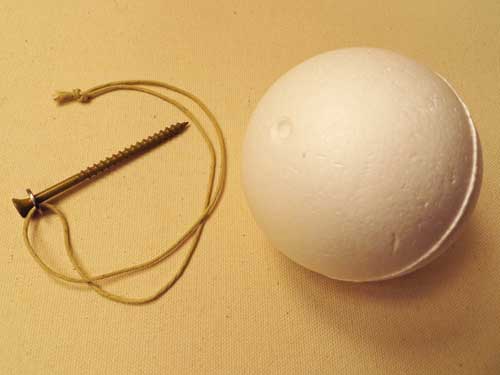I have designed a base kit that people can use to make a mosaic holiday ornament, and I plan to sell the base kit at the website. I designed the ornament base relatively quickly due to business demands, but I have spent at least 10 years thinking of how I would design mosaic kits or bases if I ever got around to it.
Design Criteria
Here are the criteria I decided were important for the holiday ornament kit:
- The kit should be only a base with instructions and not a complete kit because most people will want to pick out their own tile colors.
- The base should be reparable from generic components available at any hardware store.
- The mountings of the base should emphasize strength over shine or polish or decorative finish.
- The name of the ornament kit should avoid the word “Christmas” so that it could be used for other holidays and purposes year round.
Materials Used
The base is a 3-inch hard polystyrene foam sphere with mounting made from a loop of twine through a #8 stainless steel washer. The mounting is secured to the sphere using a 3-inch deck screw.
Note that the ornament does not hang perfectly centered from the string but is biased to one side, although the bias is slight. This was deemed preferable over a purpose-made ornament mount that would be perfectly centered yet not reliably hold the weight of a MOSAIC ornament.

Hard Polystyrene Foam Sphere 3-Inch
A wooded base would add too much weight. Styrofoam or foam of some sort was needed, but not the soft foam made for floral design. A hard foam of the type used for fishing floats was needed. I selected expanded polystyrene, which is hard and paintable, which means a white PVA glue such as Weldbond can bond to it. I chose a 3-inch sphere because that was roughly the most common size and shape of Christmas ornaments sold in the US, at least in decades past.
#9 Deck Screw 3-inch
A plain screw was chosen over an eye screw because eye screws tend to be too small or short or too heavy gauge. As far as what you can find in most hardware stores, there is no middle ground. A #9 deck screw has just the right pitch and thread length to grab onto the polystyrene. The 3-inch length was also optimal for the sphere size I had chosen. I used a deck screw because they are coated for corrosion resistance, and I wanted a fastener that could be re-glued in place if it failed years from now as the polystyrene fatigued from the weight of the mosaic.
#8 Stainless Steel Washer With Twine Loop
The #8 washer can accommodate a twine loop and the shaft of the deck screw yet not slip over the head of the deck screw. Stainless steel was selected for corrosion resistance.
Design Philosophy
There are all sorts of ornament mounts that we could have purchased from China that are purpose-made and shiny and all that. The problem is that the mounts made for Christmas ornaments aren’t made to hold the weight of a mosaic, especially over the course of years.
The hardware I selected to mount the ornament was based on strength and durability and repairability. After all, why does it need to be shiny and decorative if the mosaic underneath it will be shiny and decorative enough? Not only that, shouldn’t a hand-made ornament look hand made?
Field Reparable From Generic Components
If someone uses my base kit to make a family heirloom that is passed down generation to generation, the most important aspect of the base should be durability followed by repairability. After all, I didn’t want anyone to have to throw away their great grandma’s ornament simply because they couldn’t fix it.
When I was pursuing my first engineering degree, I worked an internship at an aerospace defense contractor so I could steal the plans for the death star and send them to the rebel alliance. (Actually I worked the internship because I was clueless in general, especially as to how I could ever figure out how to use an engineering degree to live the life I really wanted to live and make art full time.)
Anyway, while I was there I studied the military hardware doctrines of the Soviet Red Army and how they contrasted with that of NATO. While US designs for jets and tanks and other weapons systems were pushing the envelope in terms of sophistication and complexity, the Soviet design philosophy was more pragmatic: supply chains in times of war are easily disrupted, so don’t make anything that couldn’t be repaired in the field with generic components.
The ornament base I designed uses generic mounting hardware that could be easily sourced and replaced.
Failure Mode Effects Analysis
When teams of engineers are designing a new product in the corporate workplace, they do something called “Failure Mode Effects Analysis,” which is a study of how the product might fail in different ways and what the likely effects are of each mode of failure. For example, if the power switch for a vacuum cleaner shorts out, does the vacuum simply stop working or could it electrocute someone?
I applied this methodology to the mounting of the mosaic ornament and quickly rejected all the purpose-made ornament mounts I saw on the market. None of them seemed likely to support the weight of a mosaic. I also applied this principle to generic screws and hardware. If or when the mounting screw pulls out, I wanted a fastener coated with something that a white PVA adhesive such as Weldbond could bond to. That is why I selected a deck screw which has a corrosion-resistant coating instead of bare steel or zinc. Sure my fastener might pull out after years and years, but glue could be squeezed into the hole and the same fastener re-inserted.
Most Kits Discourage Original Design
Over the years, I have looked at craft kits sold for mosaic art with an eye toward selling them myself, but I have always been turned off in a major way by what I found. Every kit I saw on the market was overpriced, cheaply made and uninspired in terms of design, with a heavy emphasis on cutesy or being easy to complete in a relatively short amount of time. I considered designing my own project kits, but I didn’t want to do anything that encouraged people to make a copy of a design instead of making their own design. I started Mosaic Art Supply to encourage people to try their own hand at design and promote Art with a capital A, not sell junk to people who wanted to make junk.
I like the base kit I have made for a holiday ornament because other than size and shape, there isn’t any constraint on what type designs people could put on the base.


Leave a Reply